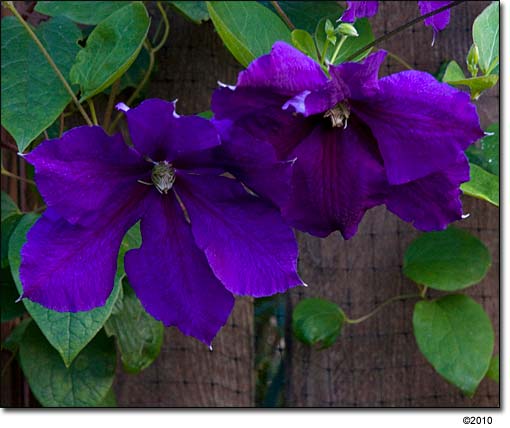Clematis 'Jackmanii'
JACKMAN'S CLEMATIS, VIRGIN'S BOWER
Family: Ranunculaceae
Pronounced: KLEM-uh-tiss
Quick Jumps
Growing Guide
Rainy Side Notes
GROWING GUIDE

Origin:
Garden.
Plant Group:
Vines.
Hardiness:
Sunset zones: A2, A3; 2-11, 14-24.
USDA zones: 4-11.
Heat zones: 9-1.
Mature size:
Height: 10-13 feet (3-4 m).
Flowering period:
July to August.
Flowering attributes:
Large, single flower with dark purple sepals, violet bars down center and yellow-green anthers.
Leaf attributes:
Deciduous, green leaves.
Light:
Full sun to partial shade.
Soil:
Fertile, humus rich, well-drained soil.
Feeding:
Mulch well with composted manure or compost. Fertilize once a month with a complete organic fertilizer during the growing season.
Propagation Methods:
Layer branches in late winter.
Basal and softwood cuttings in spring.
Division in spring.
Semi-ripe cuttings in early summer.
Pruning Methods:
Pruning group 3 or C.
Rainy Side Notes
If I were only allowed to choose one plant as my favorite, it would be a tough pick. However, today my favorite clematis is blooming—Clematis 'Jackmanii'. I know what you are thinking; this is a common clematis that's been around since forever.
You would be right! Clematis 'Jackmanii' is a tried and true commonly grown vine, and it has been in cultivation for a long time. George Jackman and his son, England, introduced it in 1858, over a century and a half ago. The reason it's often used, is its habit of profusely covering itself in velvety-looking, deep purple flowers.
Another reason it's forefront in my mind is that it was the first clematis I ever grew. It climbed up my back deck every year and showered me with its purple blossoms in summer. When we moved, I did not plant it again until recently. Living in my newer home since 1997, I planted many clematis species such as the montanas, tanguticas, and alpinas, plus many cultivars. Nevertheless, I missed "Jack." After 11 years, I planted it again in a narrow bed along the driveway where it climbs the fence. Two years later, it bloomed for the first time; and I was clearly reminded of why I missed this vine. It wasn't only nostalgia that made me miss it; its summer beauty is undeniable.
In 1863, it was awarded the Royal Horticultural Society's First Class Certificate. Over a hundred years later, it was given the RHS Award of Garden Merit.
My references give me conflicting reports on this vine's parentage. One source says it is a cross between C. lanuginosa and C. viticella. Another source says C. lanuginosa, C. 'Hendersoni', and C. 'Atrorubens'. Like some litters of puppies conceived by a roaming-at-large female in heat, we aren't sure who the papa is.
Often used in garden restorations, it's a choice clematis to use in cottage or Victorian gardens as well as our modern gardens today.
Planting and Care of Clematis.
Photographed in author's garden.

Gardening for the Homebrewer: Grow and Process Plants for Making Beer, Wine, Gruit, Cider, Perry, and More
By co-authors Debbie Teashon (Rainy Side Gardeners) and Wendy Tweton
Copyright Notice | Home | Search | Vines

